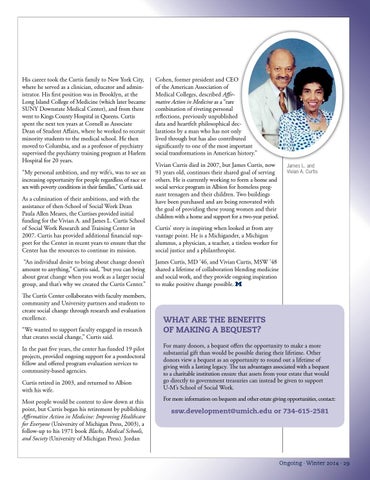His career took the Curtis family to New York City, where he served as a clinician, educator and administrator. His first position was in Brooklyn, at the Long Island College of Medicine (which later became SUNY Downstate Medical Center), and from there went to Kings County Hospital in Queens. Curtis spent the next ten years at Cornell as Associate Dean of Student Affairs, where he worked to recruit minority students to the medical school. He then moved to Columbia, and as a professor of psychiatry supervised the psychiatry training program at Harlem Hospital for 20 years. “My personal ambition, and my wife’s, was to see an increasing opportunity for people regardless of race or sex with poverty conditions in their families,” Curtis said. As a culmination of their ambitions, and with the assistance of then-School of Social Work Dean Paula Allen Meares, the Curtises provided initial funding for the Vivian A. and James L. Curtis School of Social Work Research and Training Center in 2007. Curtis has provided additional financial support for the Center in recent years to ensure that the Center has the resources to continue its mission. “An individual desire to bring about change doesn’t amount to anything,” Curtis said, “but you can bring about great change when you work as a larger social group, and that’s why we created the Curtis Center.” The Curtis Center collaborates with faculty members, community and University partners and students to create social change through research and evaluation excellence. “We wanted to support faculty engaged in research that creates social change,” Curtis said. In the past five years, the center has funded 19 pilot projects, provided ongoing support for a postdoctoral fellow and offered program evaluation services to community-based agencies. Curtis retired in 2003, and returned to Albion with his wife. Most people would be content to slow down at this point, but Curtis began his retirement by publishing Affirmative Action in Medicine: Improving Healthcare for Everyone (University of Michigan Press, 2003), a follow-up to his 1971 book Blacks, Medical Schools, and Society (University of Michigan Press). Jordan
Cohen, former president and CEO of the American Association of Medical Colleges, described Affirmative Action in Medicine as a “rare combination of riveting personal reflections, previously unpublished data and heartfelt philosophical declarations by a man who has not only lived through but has also contributed significantly to one of the most important social transformations in American history.” Vivian Curtis died in 2007, but James Curtis, now 91 years old, continues their shared goal of serving others. He is currently working to form a home and social service program in Albion for homeless pregnant teenagers and their children. Two buildings have been purchased and are being renovated with the goal of providing these young women and their children with a home and support for a two-year period.
James L. and Vivian A. Curtis
Curtis’ story is inspiring when looked at from any vantage point. He is a Michigander, a Michigan alumnus, a physician, a teacher, a tireless worker for social justice and a philanthropist. James Curtis, MD ’46, and Vivian Curtis, MSW ’48 shared a lifetime of collaboration blending medicine and social work, and they provide ongoing inspiration to make positive change possible.
WHAT ARE THE BENEFITS OF MAKING A BEQUEST? For many donors, a bequest offers the opportunity to make a more substantial gift than would be possible during their lifetime. Other donors view a bequest as an opportunity to round out a lifetime of giving with a lasting legacy. The tax advantages associated with a bequest to a charitable institution ensure that assets from your estate that would go directly to government treasuries can instead be given to support U-M’s School of Social Work. For more information on bequests and other estate giving opportunities, contact:
ssw.development@umich.edu or 734-615-2581
Ongoing · Winter 2014 · 29
